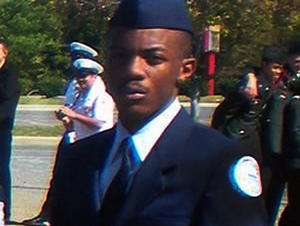Aviation securityWheel-well passengers typically die
The FAA has counted eighty-six cases of wheel-well stowaways in the United States since 1947, with the majority of them having occurred since the late 1990s; out of the cases reported by the FAA, eighteen people have survived; the TSA is mentioned to have been working collaboratively with the DHS Science and Technology Directorate to develop stowaway detection technologies

Delvonte Tisdale, the most recent high-profile stowaway // Source: thehighdefinite.com
Delvonte Tisdale, the 16-year old from North Carolina who hid in the wheel well of a Boeing 737 aircraft mid-November of last year and was later found dead, having fallen after the aircraft deployed its wheels for landing, poses security questions yet to be answered by the FAA and TSA.
Police initially suspected that Tisdale, whose body was found in a Boston neighborhood, had been murdered. An investigation, though, found that he had managed to bypass the security of Charlotte Douglas International’s tarmac and climb into the wheel-well of a Boeing 737 bound for Boston. According to Tisdale’s older brother who lives in Baltimore, Delvonte did not want to stay in North Carolina and had never wanted to leave Baltimore, where he had previously lived.
A 14 December 2010 press release details a request by Aviation Director Jerry Orr making to Police Chief Rodney Monroe to have the Charlotte-Mecklenburg Police Department (CMPD) conduct an investigation to determine how someone may have gained access to a commercial aircraft. Norfolk County, Massachusetts, District Attorney William Keating had pointed out that Tisdale has participated in an Air Force ROTC program at his high school, which may have provided him with enough familiarity with airports and aircrafts to embolden him.
The considerable dangers faced by stowaways do not seem to be enough to dissuade some from trying. Whether by ship, bus, train, or aircraft, the boarding of such means of transport is usually done illegally and without a means to attain materials of subsistence. By hanging on an airliner’s landing gear, the stowaway can easily fall to their death from the force of the wind alone. Anyone who tries to fly on an aircraft as a stowaway is confined to the landing gear area which, asides the risk from being crushed, also faces the extreme heat produced by the engines, lack of oxygen (anoxia), or from the hypothermia that may result from the prolonged exposure to the extreme colds at cruising altitudes of approximately 39,000 feet.
The FAA has counted eighty-six cases of stowaways since 1947, with the majority of them having occurred since the late 1990s, not including Tisdale. Out of the cases reported by the FAA, eighteen people have survived. According to a report by the FAA on wheel-well passengers, the individuals that had survived as stowaways claimed they were trying to “escape the living circumstances in their home country (a not-liked political or economic environment), and to start a new life in a more desirable location.”
Homeland Security NewsWire could not receive a comment from Charlotte Douglas International as to possible surveillance of Tisdale gaining access to the tarmac, although a representative from the TSA issued forth this statement: “Commercial airports are required to follow an approved Airport Security Plan that includes procedures to restrict access to secure areas. Airports are responsible for day-to-day enforcement of measures contained in these plans and are regularly inspected by TSA to ensure compliance. We will work with the airport, which is responsible for perimeter and access control security, to conduct a thorough investigation based on the facts and information provided by law enforcement. We will not comment on details of the investigation while it is ongoing.”
In a statement before the subcommittee on transportation security and infrastructure protection from 15 July 2008, the TSA is mentioned to have been working collaboratively with the DHS Science and Technology Directorate to develop stowaway detection technologies which have not yet been made public. The occasional successful stowaway who receives help from “good Samaritans” upon landing, or the unknown stowaways who might have fallen into the ocean or a remote area, might be undermining the urgency of this security issue.
